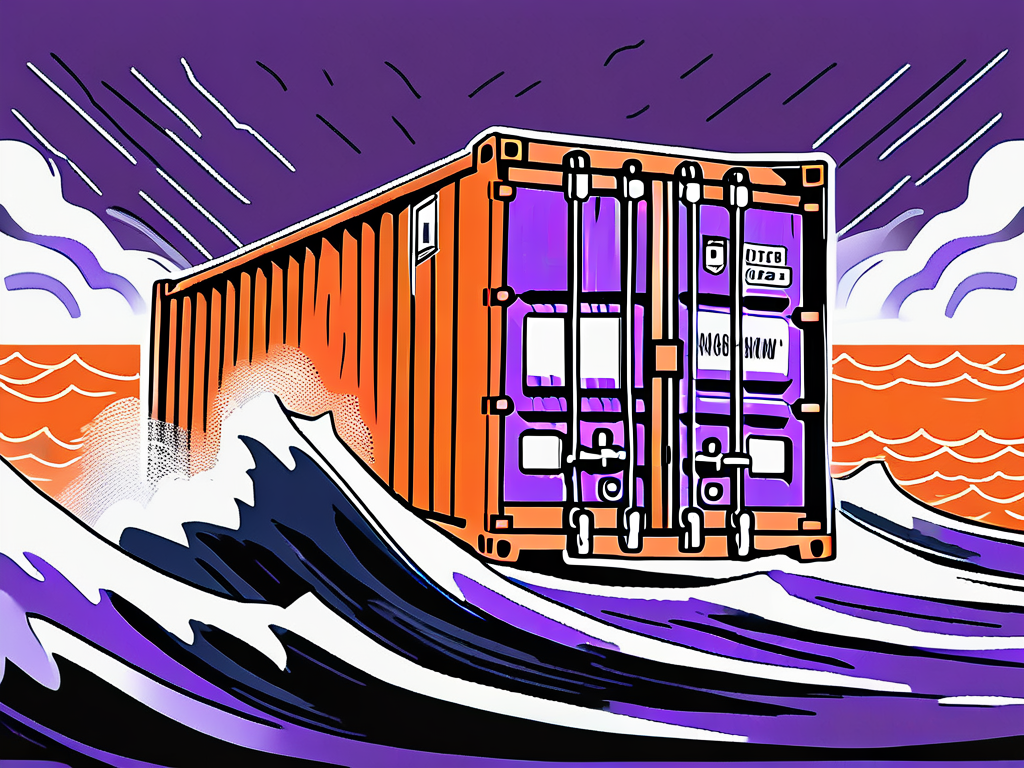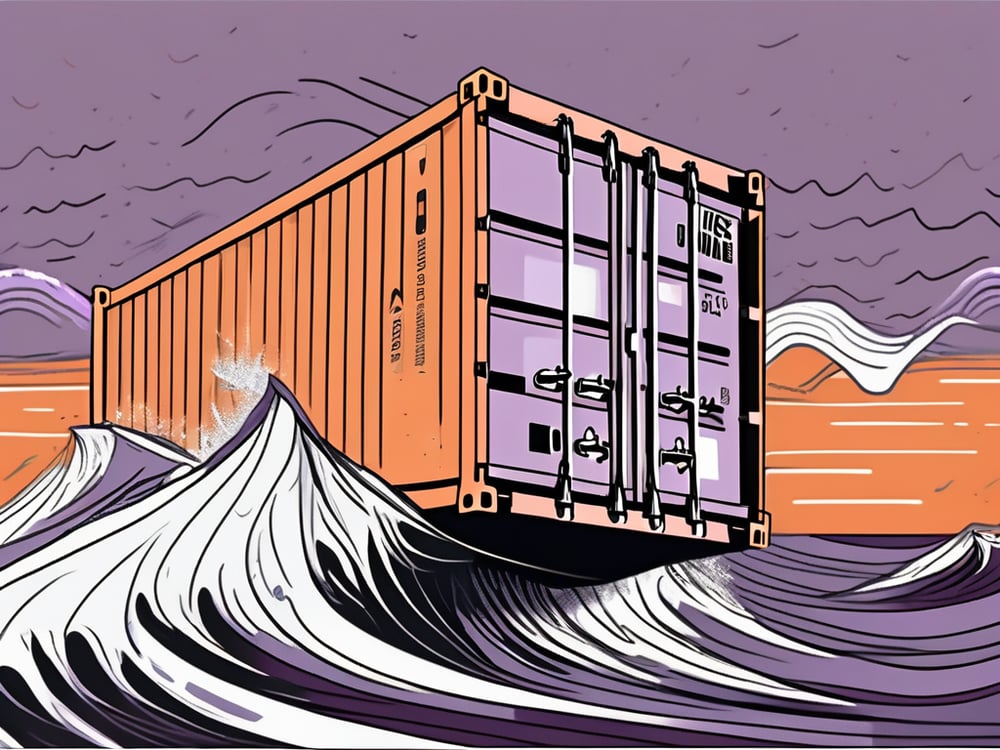Did you know that there are around 20 million shipping containers in the world today? These steel giants are essential for transporting goods across the globe, but have you ever wondered how they manage to stay securely on the ships during turbulent journeys?
In this article, we will show you precisely why shipping containers don’t fall off, while covering all the necessary details involved in the process such as:
- The features that keep shipping containers safe
- The science behind container stacking
- The safety measures, and the impact of weather conditions
So, let’s explore how these giants defy gravity and stay in place!
Table of Contents
ToggleKEY Features that Prevent a Shipping Container from Falling Off
Shipping containers use corner castings and twist locks to keep the containers aligned and secured during transportation.
Corner castings are metal fittings located at each corner of the container, providing secure attachment points for stacking. Meanwhile, twist locks are mechanisms that lock the containers together, preventing shifting while at sea.
The Role of Corner Castings and Twist Locks
Corner castings are like the cornerstones of stability in shipping containers. They facilitate the efficient stacking of containers, creating a robust structure that minimizes the risk of toppling over.
Twist locks, on the other hand, ensure that the containers remain locked together, forming a cohesive unit even when subjected to forces such as rolling waves or sudden maneuvers of the ship.
Additionally, the design of corner castings and twist locks allows for easy handling and transportation of shipping containers.
The standardized size and shape of these components enable quick and secure connections between containers, streamlining the loading and unloading process at ports around the world.
This standardized design not only enhances efficiency but also ensures compatibility across different container types and shipping vessels.
Importance of Container Weight and Balance
While corner castings and twist locks provide the physical connection between containers, weight and balance are equally vital for stability.
Shipping containers must be loaded in a balanced manner, with heavier items placed at the bottom to prevent toppling. Incorrect weight distribution can lead to an unstable stack, potentially causing containers to shift or even fall off the ship.
Furthermore, maintaining proper weight distribution within a container is essential not only for stability during transit but also for the safety of handling equipment and personnel.
Overloading one side of a container can result in uneven weight distribution, making it challenging to lift and move the container safely.
By adhering to weight limits and balance guidelines, shipping companies ensure the smooth and secure transport of goods while minimizing the risk of accidents or damage to the containers.
The Science Behind Container Stacking
When it comes to stacking containers on ships, the roles of science and engineering cannot be overstated. The stability of a container stack in the marine environment relies heavily on understanding the principles of interlocking and the dynamics of wind and wave forces.
This knowledge is crucial to ensure that the containers withstand the rigors of sea travel. The process is a unique mix of art and science, requiring precise calculations and strategic planning to achieve a stable and safe transport system for goods across the oceans.
This involves not just the physical stacking, but also careful consideration of weight distribution, the center of gravity, and the overall structural integrity of the assembled stack.
Key Aspects of Container Stacking on Ships
The Principle of Interlocking:
- Containers are placed in a specific manner for interlocking, creating a secure structure.
- The bottom containers serve as the foundation, with each subsequent layer locked in place to prevent slipping and ensure the stack moves as a single unit.
- This method improves the efficiency of port loading and unloading operations and reduces accident risks.
The Effect of Wind and Wave Forces:
- The forces exerted by high winds and rough seas can be substantial, but container design and stacking methods help distribute these forces evenly.
- Ships are equipped with ballast tanks to maintain stability against the natural elements.
- Ongoing engineering studies and the application of technologies like computer simulations and real-time monitoring enhance container stack resilience.
Understanding these principles and their applications not only ensures the safe transport of goods but also streamlines the efficiency and safety of maritime logistics operations.
Safety Measures in Container Shipping
Ensuring the safety of shipping containers goes beyond just their design and stacking. The industry implements various safety measures to mitigate risks and protect both the cargo and the crew.

Container shipping is a complex and intricate process that requires meticulous attention to detail to ensure the safe transportation of goods across vast distances.
From the moment a container is loaded onto a vessel to its arrival at the destination port, multiple safety measures are in place to safeguard against potential hazards and ensure smooth operations.
The Use of Lashing Equipment
A vital safety measure in shipping container transportation is the use of lashing equipment. Lashing involves securing containers to the ship’s deck using heavy-duty straps or chains.
This provides an additional layer of protection, preventing containers from sliding or tipping over in rough weather conditions.
Skilled crew members are responsible for properly lashing the containers, taking into account factors such as weight distribution, weather conditions, and vessel movements.
The tension and positioning of the lashing equipment are carefully monitored throughout the voyage to ensure the containers remain securely in place, even when faced with challenging sea conditions.
Regular Inspections and Maintenance
Maintaining the structural integrity of shipping containers is crucial to their stability. Regular inspections and proactive maintenance help identify any potential issues or damages in advance.
Container shackles, twist locks, and corner castings are closely inspected to ensure they are in optimal condition, reducing the risk of failure during sea voyages and preventing containers from falling off.
Furthermore, ongoing maintenance tasks such as repainting, rust removal, and structural repairs are carried out to extend the lifespan of the containers and ensure they meet industry standards for safety and durability.
By adhering to strict maintenance schedules and quality control protocols, shipping companies can minimize the risk of accidents and ensure the reliable transport of goods worldwide.
The Impact of Weather Conditions on Container Stability
Nature can be unpredictable, and the shipping industry must be prepared to face adverse weather conditions. Storms at sea and strong winds can pose significant challenges, potentially compromising the stability of container stacks.
Understanding the intricate relationship between weather conditions and container stability is crucial for ensuring the safe transportation of goods across the globe.
The structural integrity of container ships is put to the test when faced with harsh weather elements, highlighting the importance of proactive measures to mitigate potential risks.
Preparing for Storms at Sea
Shipping companies closely monitor weather forecasts to prepare for impending storms. When adverse weather is expected, precautions include reinforcing container stacks and adjusting the ship’s ballast to enhance stability. These measures help minimize the risk of containers shifting or falling off during turbulent conditions.
In addition to reinforcing container stacks, advanced technology such as real-time weather tracking systems plays a pivotal role in enhancing preparedness.
By leveraging data analytics and predictive modeling, shipping companies can make informed decisions to safeguard container stability and crew safety in the face of adverse weather events.
Mitigating the Effects of High Winds
High winds are a common occurrence at sea, and they can exert considerable force on container stacks. To counteract this, containers are designed with a tapered shape that reduces wind resistance.
The streamlined profile helps minimize the impact of strong winds, enabling the containers to maintain their stability and stay in place.
Furthermore, ongoing research and development in materials science have led to the creation of innovative lightweight yet durable materials for container construction.
These materials offer enhanced strength and resilience, contributing to the overall stability of container stacks even in the face of challenging weather conditions.
Innovations in Container Shipping Safety
The shipping industry is continuously evolving, and innovative technologies are being developed to further enhance the safety of container shipping.
One area of significant advancement is the implementation of state-of-the-art container tracking systems on modern container ships. These systems go beyond basic GPS tracking and utilize a combination of satellite communication and onboard sensors to provide real-time monitoring of container positions and movements.
By continuously analyzing data such as weight distribution and environmental conditions, these advanced tracking systems help shipping companies proactively address any potential stability issues that could compromise the safety of the cargo and the vessel.
Advanced Container Tracking Systems
Modern container ships are equipped with advanced tracking systems that monitor container positions and movements in real-time. These systems enable shipping companies to quickly identify and address any potential instability issues, ensuring the safety of both the cargo and the vessel.
Furthermore, the data collected by these tracking systems can be used to optimize container stowage plans, ensuring that weight is evenly distributed throughout the ship to minimize the risk of accidents such as container stack collapses.
This proactive approach to container management not only enhances safety but also improves operational efficiency and reduces the environmental impact of container shipping.
Future Developments in Container Security
Looking forward, ongoing research and development efforts focus on improving container security. Technologies such as smart sensors and artificial intelligence are being explored to enhance container tracking, stability analysis, and early warning systems.
These developments aim to further reduce the risk of containers falling off and enhance the overall safety of the shipping industry.
Moreover, future advancements in container security may also involve the integration of blockchain technology to create secure, tamper-proof records of container movements and handling.
By leveraging blockchain, shipping companies can establish a transparent and immutable chain of custody for each container, reducing the likelihood of tampering, theft, or unauthorized access.
This heightened level of security not only protects the cargo but also instills greater trust among stakeholders in the global supply chain network.
Innovations in Shipping Industry Are Taking Shipping Container Safety to a Whole New Level
Next time you see a towering stack of shipping containers on a vessel, marvel at the engineering marvel behind their stability.
Through intelligent design, strategic stacking, and robust safety measures, shipping containers defy gravity and stay securely in place, enabling goods to be transported safely across the seas.
The shipping industry’s continuous pursuit of innovation and safety advancements ensures that these steel giants will continue to sail the oceans without fear of falling off.






